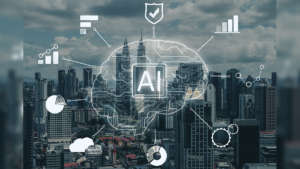Not a week goes by without some significant AI announcement, and the discussion of AI’s impact is solid fodder on event panels. I have no doubt that AI is already transforming lots of parts of the industry, and lots of our day-to-day experience.
Even in the current backdrop, these last few weeks have been huge in terms of AI announcements, and potential implications for each part of the ecosystem.
Let’s begin with the start of the roll out of the new Search Generative Experience (SGE) on Google – moving to curate AI generative summaries of topics, almost like answer cards, and answer complex questions by blending responses from sources, versus providing highest-rank match to a search term and link off as before. There will be ad opportunities here, but these are not at the publisher level and more ad opportunities within the search engine itself.
This may well be a better experience for consumers, and certainly represents the need for Google to integrate search and AI and form a protective position against emerging new models.
These changes impact the whole digital landscape and provide a further challenge to publishers gaining traffic from search engines, at a time when Facebook and other social media have also diminished referral levels.
Furthermore, we can expect to see more tools developed off the back of this, such as custom-cut models, or applications to surface information to consumers. Open AI is building a marketplace.
The influence of AI is already well proliferated through planning and buying tools – either AI or ML informing custom algorithms. For instance KOA integrated into the Trade Desk, and Scibids at Doubleverify. The support here is across the board, from optimisation, to creative generation and brand safety and fraud protection.
I am personally using AI within my work (this article is AI free however unless disclosed), mainly for refining my already-written thoughts, and structuring proposals or presentations. I was lucky to hear Ravleen Beston talk at the IAB UK leadership event about how she was using Microsoft’s Copilot to assist in her everyday workflow.
Similarly, Rob Webster wrote a great piece on Linkedin about how AI is informing his everyday and how people need to lean in to use technology.
So I conducted an unscientific survey amongst a group of former colleagues to see how people where using AI (mainly Chat CPT, CoPilot or Gemini in these cases).
Out of 29 responses – 21% use AI daily, 41% Weekly, and the remainder occasionally. No one was never!
The use cases were a bit more varied – 44% for document / presentation writing, 6% for editing previous work and 45% for research/information sourcing.
This raises the question of AI ethics and data security – alongside AI consent for your data to be used in a training model. Interestingly, a privacy friend of mine is taking a role with the impacts of AI ethics, and commercial licensing at its core.
How much of this is also a media industry bubble – well anecdotally I’ve heard of great uses in education – alongside the challenge of plagiarism, and I know that AI is being used to inform strategy presentations in some other industry.
So what’s the outcome from this flurry of thoughts?
- It’s time to start using, or thinking about how you use AI in your day0-to-day work life
- Consider the ethics, and consider any use of data you feed in – I have a simple policy of not using any client data at this time
- Learning how to imbed AI enhances your value, not decreases it as Rob clearly says.
This is a great five-minute explainer of how AI works – from my friend Josh Patridge at Newsroom.AI.
Finally – I thought I’d ask AI to do my work for me – my review on the below is:
- ● It’s not there yet
- ● It’s pretty good and will get better
- ● This could be quickly refined with better prompts, and follow up questions.
This is what I did:
- Prompt: Write me a 800 word article on the impact of AI in the digital advertising market in EMEA, with the latest product releases from Google and Open AI – and the common uses in media buying (the only changes I have made to the below is correcting American spellings to english. The Impact of AI in the Digital Advertising Market in EMEA The digital advertising market in Europe, the Middle East, and Africa (EMEA) is undergoing a transformative evolution driven by advancements in artificial intelligence (AI). As the region continues to embrace digitalization, AI’s integration into advertising strategies has significantly altered how brands engage with consumers, optimise campaigns, and measure success. The latest product releases from tech giants like Google and OpenAI highlight the critical role AI plays in this dynamic landscape.
This is what it came up with. Judge for yourself which is best!
The Role of AI in Digital Advertising
AI’s impact on digital advertising can be categorised into several key areas: audience targeting, personalization, programmatic media buying, and performance measurement. By leveraging AI, advertisers can create more precise and effective campaigns, reaching the right audiences at the right time with tailored messages.
Audience Targeting and Personalization: AI algorithms analyse vast amounts of data to identify patterns and predict consumer behaviour. This capability allows advertisers to segment their audiences more accurately and deliver personalised content that resonates with individual preferences. For instance, machine learning models can analyse browsing history, purchase behaviour, and social media activity to create detailed consumer profiles. This data-driven approach enhances the relevance of advertisements, leading to higher engagement and conversion rates.
Programmatic Media Buying: One of the most significant advancements in digital advertising is the use of AI in programmatic media buying. Programmatic advertising automates the buying and selling of ad inventory in real-time through AI-driven platforms. This automation ensures that ads are placed in front of the most relevant audiences, optimising ad spend and improving ROI. AI-powered platforms can analyse data from multiple sources, including websites, apps, and social media, to make instant decisions about which ads to display and where to place them
Latest AI Product Releases from Google and OpenAI
The continuous innovation from industry leaders like Google and OpenAI is shaping the future of digital advertising. Recent product releases from these companies demonstrate the growing sophistication and application of AI in the advertising sector.
Google’s AI Innovations: Google has been at the forefront of integrating AI into its advertising products. One of the notable releases is Google Ads’ Performance Max campaigns. This new campaign type uses AI to optimise performance across all of Google’s inventory, including YouTube, Display, Search, Discover, Gmail, and Maps. Performance Max campaigns use machine learning to automate ad creation, targeting, and bidding, helping advertisers achieve their marketing goals with minimal manual intervention.
Another significant release is Google Analytics 4 (GA4), which incorporates advanced AI capabilities to provide deeper insights into consumer behaviour. GA4
uses machine learning to predict future actions, such as potential purchases or churn, allowing advertisers to proactively adjust their strategies.
OpenAI’s Contributions: OpenAI, known for its powerful language models like GPT-4, has also made strides in the advertising space. GPT-4 can generate high-quality ad copy, social media posts, and even entire marketing campaigns. Its ability to understand and mimic human language allows for the creation of compelling and contextually relevant content. This can significantly reduce the time and effort required to produce effective marketing materials, while also ensuring consistency and creativity.
OpenAI’s models can also analyse consumer feedback and sentiment from various sources, providing valuable insights into public perception and brand reputation. This information helps advertisers fine-tune their messaging and better address consumer needs and concerns.
Common Uses of AI in Media Buying
AI’s integration into media buying processes has revolutionised how advertisers allocate their budgets and optimise their campaigns. Some common uses include:
Real-Time Bidding (RTB): AI-driven RTB platforms enable advertisers to bid for ad space in real-time. These platforms analyse user data to determine the value of displaying an ad to a specific audience segment at a particular moment. This ensures that advertisers are willing to pay the right price for the right impression, maximising the efficiency of their ad spend.
Ad Creative Optimization: AI tools can automatically generate and test multiple variations of ad creatives. By analysing which versions perform best, AI can optimise the design, messaging, and placement of ads. This continuous improvement cycle helps in achieving higher engagement rates and better overall campaign performance.
Predictive Analytics: AI models can predict future trends and consumer behaviour based on historical data. This capability allows advertisers to anticipate changes in market conditions and adjust their strategies accordingly. For example, predictive analytics can forecast peak shopping periods or emerging consumer preferences, enabling brands to stay ahead of the competition.
Fraud Detection: AI plays a crucial role in detecting and preventing ad fraud, which is a significant concern in the digital advertising industry. Machine learning algorithms can identify suspicious patterns and flag fraudulent activities, such as click fraud or
impression fraud, protecting advertisers’ investments and ensuring the integrity of their campaigns.
Conclusion
AI’s impact on the digital advertising market in EMEA is profound, offering enhanced targeting, personalization, and efficiency. The latest innovations from Google and OpenAI underscore the potential of AI to revolutionise advertising strategies. As the technology continues to evolve, advertisers in the EMEA region must stay abreast of these developments to leverage AI’s full potential, ensuring they remain competitive in an increasingly data-driven marketplace. The integration of AI in media buying not only optimises ad spend but also drives more meaningful engagement with consumers, ultimately leading to better business outcomes.










